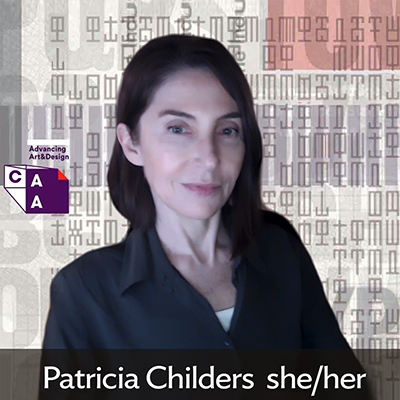CAA News Today
Patricia Childers
posted by Allison Walters — Dec 02, 2020
 Statement
Statement
My career has been in the educational environment, focusing on graphic design and critical studies. I see intellectual engagement as a place of possibilities. In addition to teaching design, I practice professionally, and am an active member of many design organizations. But the structure of life has changed. The global pandemic, compounded with continuing issues of basic human rights and a deteriorating climate, has affected much that we value.
The MFA class of 2020 has experienced not only a loss of employment opportunity, but a loss of the support that contributed to our wellbeing. Loss, like the disbanding of The Type Director’s Club, an organization that I’ve actively supported for years, contributes to our overwhelming isolation. I am a member of the first class to graduate into this state of precarity. But uncertainty weighs heavily on the entire profession. When I facilitated a round-table discussion at the AIGA Design Educators conference, our chat box overflowed with requests for resources and advice to help navigate in isolation.
Apprehension during the transition from student to professional is not a recent phenomenon. The scarcity in teaching positions existed long before this pandemic. And a lack of guidance in writing and publishing, continuing to make work without a deadline, the expectations of maintaining scholarship and service, can daunt.
Resources like CAA assist by providing everything from creating CVs to webinars on interviewing, with efforts to demystify salaries, create mentorship programs, adjunct and labor advocacy, and sessions such as “Get Up, Stand Up: Contingent Faculty and the Future of Higher Education in the Visual Arts.” In CAA’s Art Journal Open (AJO) Kristen Galvin and Christina M. Spiker addressed the system itself. “The Cost of Precarity: Contingent Academic Labor in the Gig Economy” stated that robust discourse depends on a viable institutional ecosystem—healthy interaction and balance between populations to ensure resilience to various types of external stressors.
Today, our resilience is being tested as COVID-19 social distancing magnifies existing issues and forces us to adapt. However, our adopted platforms for communication have integrated and flattened traditional hierarchal structures of engagement. Event participation, although limited by technological advantage, is no longer limited by location. This expanded engagement has diversified communities as isolated transactions grow into ongoing relationships. Many of our “wicked problems” are being addressed through this immediate connection of people, ideas, and action.
I offer the first-hand experience of a recent student and emerging professional navigating the unpredictable. If elected, I will represent the organization’s future leaders, a group honed by adopting to crisis. But I’ve found this crisis to be a catalyst for possibilities. Platforms that provide social fraternization and leadership can build stable foundations for the future. These systems not only build relationships—but build platforms that allow others to build relationships. Through engagement, we can build for the new normal.


